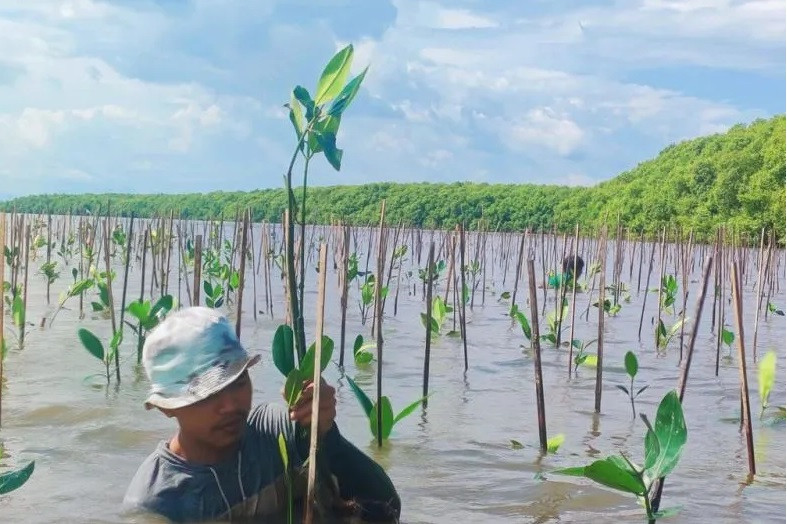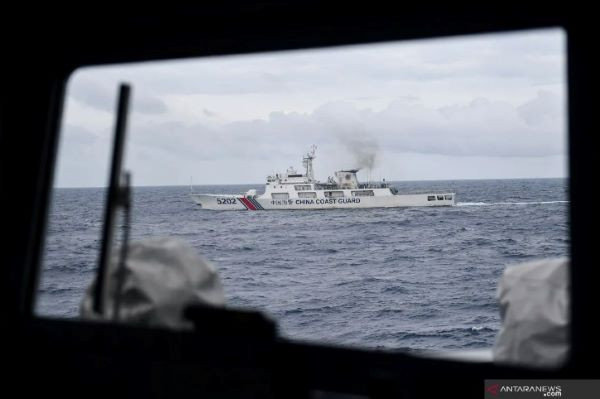Indonesia’s green belt – Protecting and restoring the country’s mangroves
Restoration needs to go beyond the planting of seedlings and include hydrological works to reestablish tidal flows and allow for mangrove seeds from nearby mangrove forests to disperse.
Change Size
 Protective plants: Local resident takes part in the planting of mangrove seedlings in Marannu village in Maros regency, South Sulawesi on May 26, 2022. (Courtesy of/South Sulawesi provincial government)
Protective plants: Local resident takes part in the planting of mangrove seedlings in Marannu village in Maros regency, South Sulawesi on May 26, 2022. (Courtesy of/South Sulawesi provincial government)
I
ndonesia’s Group of 20 presidency – under the banner of “Recover Together, Recover Stronger” -- encourages member countries to achieve green economic recovery, and showcases Indonesia’s own vision to achieve green and low-emissions economic development.
The Agriculture, Forest and Land Use (AFOLU) sector has historically contributed the largest share of the country’s Greenhouse Gases (GHG) emissions, approximately 43 percent in 2016, according to Indonesia’s updated National Determined Contribution (NDC) to the United Nations. The government has enacted several related policies, including the ambitious target of converting forests and other types of land into a “carbon sink” by 2030. Achieving this will take bold policy changes and investments in different areas, particularly to protect critical, carbon-rich ecosystems such as primary forests, peatlands, and mangroves.
Indonesia harbors the largest area and diversity of mangrove ecosystems in the world. Mangroves support coastal livelihoods through fisheries (fish, crab, and other seafood), protect the country’s coasts from disasters, and store 3.14 billion tons of CO2, playing a significant role in mitigating global climate change. Recent World Bank research found Indonesia’s mangroves are worth approximately US$15,000 per hectare on average, with some locations – particularly those near developed coastal areas -- worth about $50,000, due to their role in flood protection.
Despite having significant value, mangroves are regularly lost and converted to other uses, including aquaculture, agriculture, and infrastructure (including for housing and tourism). People living in coastal areas previously protected by mangroves are at higher threat from coastal disaster events such as flooding, erosion, and storms as well as decreased fish productivity.
Mangrove conversion also leads to biodiversity loss and significant greenhouse gas (GHG) emissions into the atmosphere, contributing to climate change. A recent study suggested that in this past ten years, mangrove conversion contributed to almost 200 million tons of CO2 going into the atmosphere, equivalent to the electricity use in over 35 million homes for one year.
The government of Indonesia has boldly committed to restore 600,000 ha of mangroves by 2024 – the world’s largest mangrove restoration ambition to date. However, restoration is costly - an average of $1,640 to $3,900 per hectare in Indonesia -- and has experienced high failure rates throughout the world. Hence, conservation of healthy ecosystems should be prioritized over restoration. Based on Indonesia’s National Mangroves Map (2022), over 90 percent of Indonesia’s mangroves are in “good condition”, suggesting there is ample room for conservation efforts.
Indonesia has implemented various efforts to conserve mangroves, including launching the Mangrove One Map to understand the extent and quality of mangroves throughout Indonesia. The Environment and Forestry Ministry in 2021 has also issued an official guideline for the Implementation of mangroves management that involves community participation.
These efforts could be complemented, including by strengthening the overarching policy on the management on mangroves and including the designation of mangroves zoning into spatial planning to guide policy and investment decision, such as coastal infrastructure development. The government of Indonesia could also expand the scope of its existing moratorium on issuing licenses to convert primary forest and peatlands to include all types of mangroves.
Restoring degraded mangroves can bring back its ecological functions: Habitat for fisheries, protecting the coastline and more; and can have significant local and global impact. However, mangrove restoration came with significant technical, social, and economic challenges. Hence, adopting three actions below is critical to enhance the success rates.
First, mangrove restoration needs to be firmly anchored in an “integrated landscape management”, which means conserving and restoring while strengthening the resilience of coastal communities. This integrated landscape approach requires cross-sectoral coordination with national, subnational, and local institutions (government, NGOs and local communities) to plan, execute, and evaluate mangrove management.
Second, restoration needs to go beyond the planting of seedlings and include hydrological works to reestablish tidal flows and allow for mangrove seeds from nearby mangrove forests to disperse. The specific condition of the areas to be restored, quality of seedlings, medium-term management (e.g. tending, protection) and mid-course corrections can increase success rates.
Finally, the willingness, commitment, and engagement of local stakeholders to allow and support restoration is key and this requires providing them with concrete benefits in the short and medium term to participate in restoration and care for restored areas. Restoration can have significant impact on local communities, as it creates a link between their day-to-day life with efforts to protect their environment. Payment for labor-intensive work and other incentives mechanism, including payments for blue carbon can secure the support of local communities and governments.
The recently launched Mangroves for Coastal Resilience project, financed by the World Bank, supports the government’s ambitious goals of mangroves restoration while embracing the principles above. This project aims to strengthen management of mangroves in four priority provinces, while developing an integrated model of mangrove conservation and restoration and improving livelihoods of coastal communities that can be replicated throughout the country.
The government is also implementing an overarching policy for mangroves management, strengthening cross sectoral coordination at national and local levels, as well as exploring potential blue carbon payments for mangroves.
Mangroves are Indonesia’s green belt – important for local and national communities, and the world. Large-scale conservation and restoration are challenging but doable. The government of Indonesia has taken the first steps in this direction with supports from several partners. Maintaining this route over the medium-term will be critical for success.
***
The writer is World Bank senior natural resources management specialist.









